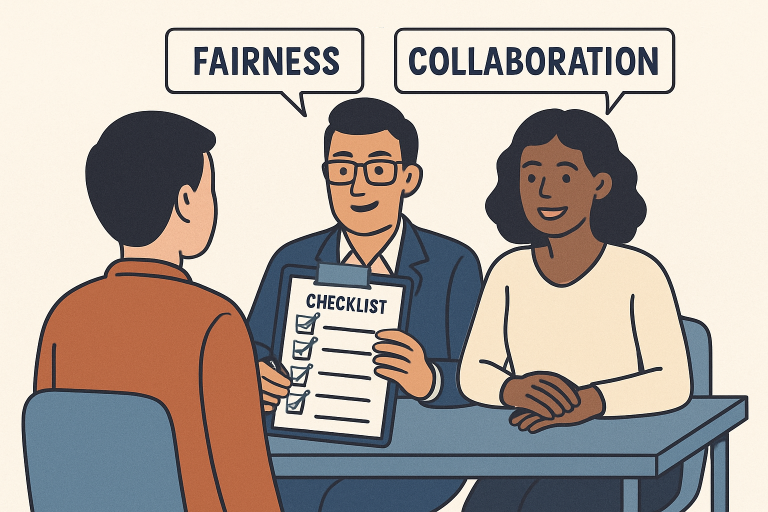Key Takeaways
- Interview scorecards help reduce bias by providing objective criteria for candidate assessment.
- Structured interviews lead to more consistent and data-driven hiring decisions.
- Transparency and collaboration are strengthened when teams use shared evaluation tools.
- Modern tools make implementing scorecards easier than ever for organizations of all sizes.
1. Why Fair Hiring Still Matters
Fair hiring is more than a compliance issue—it’s a strategic advantage that directly impacts a company’s ability to innovate and succeed in a rapidly changing world. Companies with strong fair hiring practices attract top talent from diverse backgrounds, improve employee retention, and create more inclusive cultures. When hiring is equitable, teams benefit from a broad spectrum of perspectives, which can enhance creativity and performance.
Recent research continues to demonstrate the crucial link between diverse teams and improved business outcomes. Ensuring fairness in hiring requires consistent, systemic approaches that remove subjectivity and mitigate unconscious bias. One of the most effective solutions is the use of structured interview tools, such as the interview scorecard sheet. By standardizing evaluation criteria, scorecards enable organizations to focus on skills, experience, and cultural alignment, rather than relying on gut instincts or perceptions.
Investing in structured hiring tools is no longer limited to large enterprises. Thanks to modern platforms, even smaller businesses can benefit from robust systems that support fair and effective candidate assessments.

2. What Is an Interview Scorecard?
An interview scorecard is a structured evaluation tool designed to help interviewers assess candidates consistently against predefined criteria. Core components typically include a list of competencies, rating scales, and descriptive behavioral anchors that clarify what constitutes strong, average, or weak performance for each criterion.
Unlike unstructured interviews, where decisions are often made based on “gut feeling,” scorecards provide a transparent, replicable framework. This approach reduces the risk of inconsistent or biased evaluations, enabling data-driven comparisons between candidates. As highlighted in Forbes, modern hiring practices utilize tools like interview scorecards, which play a crucial role in setting companies apart by creating fairer and more reliable hiring outcomes.
3. How Interview Scorecards Support Consistent Candidate Evaluation
Structured scorecard use ensures each candidate is evaluated on the same set of criteria, in the same way, and by every interviewer. This contrasts sharply with informal methods, where one interviewer’s biases or incomplete impressions may overshadow objective assessment.
For example, in an unstructured interview, an interviewer may weigh small talk or first impressions too heavily, potentially overlooking key skills or cultural aspects. With scorecards, every required competency is addressed, discussed, and documented, resulting in more reliable hiring decisions.
4. Reducing Unconscious Bias Through Structure
One of the most powerful benefits of interview scorecards is their ability to mitigate unconscious bias. By focusing the assessment on pre-agreed standards rather than subjective impressions, scorecards ensure each candidate starts from a level playing field. Several studies have shown that structured interviewing reduces the influence of stereotypes and cognitive shortcuts that can jeopardize fair outcomes.
5. Designing an Effective Interview Scorecard
Effective interview scorecards are based on well-defined job requirements and reflect both technical and soft skills relevant to the role. Essential elements include:
- Clear evaluation criteria: Each criterion should directly relate to the responsibilities and desired outcomes of the position.
- Behavioral anchors: Examples of what high, medium, and low performance look like help calibrate ratings across interviewers.
- Consistent rating scales: Typically a 1-5 or 1-4 scale, enabling summary scores and objective discussion.
To align scorecards with company values and job specifics, involve hiring managers and the hiring team in their development. Start by reviewing the job description and prioritizing the must-have attributes. Then, collaboratively draft criteria and behavioral examples that embody the organization’s culture and needs.
6. Implementing Interview Scorecards in Collaborative Hiring
For maximum effectiveness, integrate scorecards into each stage of the interviewing process. In panel interviews or collaborative assessments, provide each participant with a scorecard, encouraging them to rate candidates in real-time. This minimizes the influence of groupthink and helps capture a genuine diversity of perspectives before team discussion begins.
Regular feedback loops, in which interviewers compare scores and discuss reasons for their ratings, lead to richer collective decision-making.
8. The Future of Interview Scorecards and Fair Hiring
Technology is rapidly transforming how organizations approach structured hiring. Artificial intelligence, machine learning, and digital collaboration platforms now offer advanced tools for creating, sharing, and analyzing interview scorecards. These innovations streamline feedback, surface hiring trends, and offer actionable insights into bias or inconsistency within the process.
Looking ahead, expect inclusive design, greater flexibility, and broader adoption of structured evaluation methods to become the new normal. As organizations prioritize transparency and accountability, interview scorecards will continue to play a pivotal role in driving hiring practices that are not only fair but also effective and future-ready.
Conclusion
Implementing interview scorecards is one of the most practical and impactful steps organizations can take to promote fair, collaborative, and data-driven hiring. By shifting from intuition-led interviews to structured scorecard-based assessments, companies reduce bias, enable better decisions, and set the stage for long-term team success.
It’s time to invest in transparent, systematic hiring processes that empower both interviewers and candidates. With the right tools and commitment, every organization can build a more equitable and effective recruitment strategy.